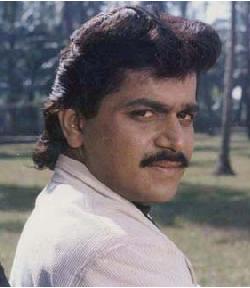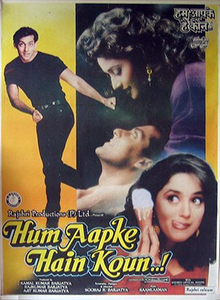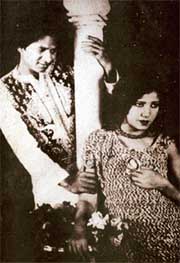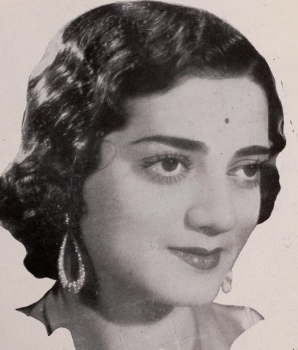Related Research Articles

Hindi cinema, popularly known as Bollywood and formerly as Bombay cinema, refers to the film industry based in Mumbai, engaged in production of motion pictures in Hindi language. The popular term Bollywood is a portmanteau of "Bombay" and "Hollywood". The industry is a part of the larger Indian cinema, which also includes South Indian cinema and other smaller film industries.

Mother India is a 1957 Indian epic drama film, directed by Mehboob Khan and starring Nargis, Sunil Dutt, Rajendra Kumar and Raaj Kumar. A remake of Khan's earlier film Aurat (1940), it is the story of a poverty-stricken village woman named Radha (Nargis), who in the absence of her husband, struggles to raise her sons and survive against a cunning money-lender amidst many troubles.

Laxmikant Berde was an Indian Marathi language film actor who appeared in Marathi and Hindi movies. Known for his highly energetic slapstick performances, Berde started his career as an employee in the production company Mumbai Marathi Sahitya Sangh and then played supporting roles in a few Marathi stage plays. In 1983–84, he first became famous with the Marathi play Tur Tur.

Hum Aapke Hain Koun..! also known by the initialism HAHK, is a 1994 Indian Hindi-language musical romantic drama film written and directed by Sooraj Barjatya and produced by Rajshri Productions. The film stars Madhuri Dixit and Salman Khan and celebrates Indian wedding traditions by means of a story of a married couple and the relationship between their families; a story about sacrificing one's love for one's family. The basic plot is based on studio's earlier film Nadiya Ke Paar (1982), which was based on Keshav Prasad Mishra's Hindi novel Kohbar Ki Shart. The film features music by Raamlaxman who also composed a 14-song soundtrack, an unusually large number of songs for that period.

Sahib Bibi Aur Ghulam is a 1962 Indian Hindi-language drama film that was directed by Abrar Alvi and produced by Guru Dutt, who also co-stars in it alongside Meena Kumari, Rehman, and Waheeda Rehman. The film, which is based on Bimal Mitra's Bengali-language novel Saheb Bibi Golam (1953) which was the second adaptation of the novel after the 1956 Bengali film with the same title Saheb Bibi Golam starring Sumitra Devi, Uttam Kumar and Chhabi Biswas. Having seen the novel and its staged version, Dutt wanted to adapt Saheb Bibi Golam into a film, was set in the 19th century during the British Raj and focuses on Bhoothnath (Dutt), who meets Chhoti Bahu (Kumari), the lonely wife of a zamindar (Rehman). The film follows Chhoti Bahu's effort to keep her husband—who likes drinking and watching dancing girls perform—at their home by drinking with him. She becomes addicted to alcohol, leading both of them into bankruptcy.
Guru Dutt Films Private Limited was an Indian film production company, founded by actor-director Guru Dutt in 1955. Guru Dutt Films, along with the Guru Dutt team, saw some of its best works during the 1950s and 1960s, also sometimes referred to as the "Golden age of Indian cinema."

Masala films of Indian cinema are those that blend multiple genres into one work. Masala films emerged in the 1970s and are still being created as of the 2020s. Typically these films freely blend action, comedy, romance, and drama or melodrama. They also tend to be musicals that include songs, often filmed in picturesque locations.

Kisan Kanya was a 1937 Hindi Cinecolor feature film which was directed by Moti Gidwani and produced by Ardeshir Irani of Imperial Pictures. It is largely remembered by the Indian public on account of it being India's first indigenously made colour film.
Ranjit Studios, also known as Ranjit Movietone, was an Indian film production company with studio facilities located in Mumbai, Maharashtra, India. It produced films between 1929 and mid-1970s. The studio was founded by Chandulal Shah along with Gohar Kayoum Mamajiwala. It was one of the three largest studios in Bollywood of its time, besides Kohinoor Film Company and Imperial Film Company.
Manzilein Aur Bhi Hain is a 1974 Bollywood crime thriller film directed by Mahesh Bhatt, and starring Kabir Bedi, Prema Narayan and Gulshan Arora in lead roles. The rights of this film are now owned by Glamour Eyes Films.
A bibliography of notable books on Hindi cinema.
Shivaji, was the founder of the Maratha Empire in India. He is considered a prominent historical figure in India. A number of films, books, plays and television serials have been produced about his life and about figures associated with him.
Mohini Bhasmasur is a 1913 Indian mythological film directed by Dadasaheb Phalke and starring Kamlabai Gokhale and Durgabai Kamat. It is India's and Phalke's second full-length feature film. Mohini Bhasmasur is the first Indian film to have a female actor. In Raja Harischandra, India's and Phalke's first film, the role of the female was played by Anna Salunke, a male.

Master Vithal or Vithal (1906-1969) was an actor in Indian cinema, best known as the hero of India's first talkie Alam Ara (1931) and of Marathi and Hindi silent stunt films, which gave him the epithet as the Douglas Fairbanks of India.

Gyan Mukherjee was an Indian film director and screenwriter, who worked in Hindi cinema, best known for the hits Jhoola (1941) and Kismet (1943).

Sabita Devi (1914–1965) was a Hindi film actress in Indian cinema. She is stated to be one of the "prominent" leading ladies of the "pioneering era" of Indian cinema along with Mehtab, Bibbo, Durga Khote, Gohar, Devika Rani and Seeta Devi. A Jewish by birth, she changed her name to find acceptability in Hindi cinema like the other Anglo-Indian and Jewish actresses of her time, Sulochana, Seeta Devi, Madhuri, and Manorama. After initially working with British Dominion Films Ltd., Calcutta, she shifted to Bombay and performed mainly in films produced by Sagar Movietone with her co-star in most films being Motilal. Some of the popular films with Motilal were Dr. Madhurika (1935) and Kulvadhu (1937) directed by Sarvottam Badami. Their first film together was Shaher Ka Jadoo (1934), which was also Motilal's debut film, and then Lagna Bandhan (1936) both directed by Kaliprasad Ghosh. She acted in Silver King (1935) with Motilal. It was an action film directed by C. M. Luhar, which became a "huge success".
Tejaswini Ganti is an Indian anthropological and film scholar and associate professor at the New York University, specializing in South Asian culture. She is an alumna from the University of Pennsylvania, the Northwestern University, and the New York University.
References
- 1 2 3 Tejaswini Ganti (2012), Producing Bollywood: Inside the Contemporary Hindi Film Industry, Duke University press, p. 187, ISBN 978-0822352136
- ↑ BOX OFFICE IN INDIA EXPLAINED
- ↑ Ashok Mittal (2003), Cinema Industry in India: Pricing and Taxation, Indus Publishing Company, p. 55, ISBN 81-7387-023-3
- ↑ Edited by Gulzar, Govind Nihalani, Saibal Chatterjee (2003), Encyclopaedia of Hindi Cinema, Encyclopædia Britannica (India) Pvt. Ltd. & Popular Prakashan Pvt. Ltd., p. 146, ISBN 81-7991-066-0
{{citation}}:|author=has generic name (help)CS1 maint: multiple names: authors list (link) - ↑ Tejaswini Ganti (2004), Bollywood: A Guidebook to Popular Hindi Cinema, Routledge, p. 58, ISBN 0-415-28854-1